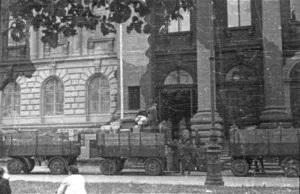The Missing Treasures of Poland

The stated potential location of the Nazi “gold train,” announced in August 2015. Image courtesy of Wikimedia Commons.
On August 28, 2015, Polish Deputy Culture Minister Piotr Zuchowski made the startling public announcement that ground penetrating radar images confirmed, with “99 percent probability,” that a 100-meter train was buried about 65 kilometers southwest of Wroclaw. Media outlets and treasure seekers around the world promptly went nuts. The official position of the Polish government on the subject remains murky—local officials and historians alike agree that it cannot be conclusively proved that a “gold train” ever left Wroclaw before its siege by Soviet troops. The idea of a gold train is itself something of a misnomer, as such trains of valuables also contained artistic masterworks, weapons, fine china, and other valuables plundered from occupied territory by the Nazi regime. Uncertainty aside, the explorers who took the GPR images, Peter Koper of Poland and Andreas Richter of Germany, have received permission to begin exploratory digging along sections of potential rail lines this month.

Nazi troops looting Warsaw’s Zacheta National Gallery of Art in 1944. Image courtesy of Wikimedia Commons.
Whether or not a train is found, and furthermore, whether it contains anything valuable, is almost beside the point. The possibility that it might have happened makes this announcement sensational. It would be impossible to talk about Poland’s cultural and artistic heritage without acknowledging one of the darkest moments of history. During and in the immediate aftermath of the Second World War, an estimated half million objects of historic, artistic, or cultural value were removed from Poland by the Nazi regime. Some of it was requisitioned for Adolf Hitler’s planned Fuhrermuseum in the city of Linz. Other pieces were kept by Nazi officials attempting to build personal collections, and others, such as the collection of the Lwow Historical Museum, a museum in the city that is now Lviv, Ukraine, were deliberately destroyed.
Like the allure of the gold train, the recovery of art looted by the Nazis has captured the popular imagination. While blockbuster movies like Woman in Gold or Monuments Men may understandably focus on the success achieved in this regard, in many cases the restitution is still a work in progress. Poland’s art repatriation was delayed when the country fell under the influence of the U.S.S.R. after the war. The return of the former Polish royal regalia, for instance, was delayed until 1961 due to concerns that it would end up in Moscow rather than a Polish museum. Other efforts were hampered by the human cost of war: those most familiar with what had been raided were no longer alive.
It is almost impossible to adequately portray or quantify the sheer scale of human cost. More than six million Poles, including much of the Jewish population were systematically murdered through concentration camps, forced labor, or simply for being in the sights of a rifle. The art is part of their heritage and legacy and a testament to the lives of many whose existence the Nazis sought to stamp out. It is a long process, and despite past success there is still a lot to be done. The Polish Ministry of Culture and National Heritage maintains a database of more than 63,000 of works of art and valuables still missing from Poland, and maintains an online presence with The Lost Museum, a digital archive of art looted or destroyed during the war. Although tens of thousands of objects remain missing, repatriations do take place. One of the most recent ones was a marble bust of Diana by Jeane-Antoine Houdon, found in an Austrian auction house and returned to the plinth from which it was stolen 75 years previously. Other pieces seen in the following gallery have either been returned, or have been in the news recently as allegedly located.
As Trust participants in 2015’s tour of Germany saw first hand, the collective past and results of war are slow to fade. Although much is missing, much has been recuperated, and this tour will be an opportunity to see the heritage of a country whose national identity has been formed just as much by its ancient triumphs as it has by its recent trials.
About The Decorative Arts Trust Bulletin
Formerly known as the "blog,” the Bulletin features new research and scholarship, travelogues, book reviews, and museum and gallery exhibitions. The Bulletin complements The Magazine of the Decorative Arts Trust, our biannual members publication.










